ASUS P3C-LS, P3C-L, P3C-S User Manual

R
P3C-L / P3C-S / P3C-LS
Rambus™ Motherboards
USER’S MANUAL
Special Features
P3C-L
•Intel® 82559 10/100 LAN Chipset
•Alert-On-LAN and Wake-On-LAN Support
P3C-S
• Adaptec® 7892 Ultra 160 SCSI Controller
P3C-LS
•Intel® 82559 10/100 LAN Chipset
•Alert-On-LAN and Wake-On-LAN Support
•Adaptec® 7892 Ultra 160 SCSI Controller

USER'S NOTICE
No part of this manual, including the products and software described in it, may be reproduced, transmitted, transcribed, stored in a retrieval system, or translated into any language in any form or by any means, except documentation kept by the purchaser for backup purposes, without the express written permission of ASUSTeK COMPUTER INC. (“ASUS”).
ASUS PROVIDES THIS MANUAL “AS IS” WITHOUT WARRANTY OF ANY KIND, EITHER EXPRESS OR IMPLIED, INCLUDING BUT NOT LIMITED TO THE IMPLIED WARRANTIES OR CONDITIONS OF MERCHANTABILITY OR FITNESS FOR A PARTICULAR PURPOSE. IN NO EVENT SHALL ASUS, ITS DIRECTORS, OFFICERS, EMPLOYEES OR AGENTS BE LIABLE FOR ANY INDIRECT, SPECIAL, INCIDENTAL, OR CONSEQUENTIAL DAMAGES (INCLUDING DAMAGES FOR LOSS OF PROFITS, LOSS OF BUSINESS, LOSS OF USE OR DATA, INTERRUPTION OF BUSINESS AND THE LIKE), EVEN IF ASUS HAS BEEN ADVISED OF THE POSSIBILITY OF SUCH DAMAGES ARISING FROM ANY DEFECT OR ERROR IN THIS MANUAL OR PRODUCT.
Product warranty or service will not be extended if: (1) the product is repaired, modified or altered, unless such repair, modification of alteration is authorized in writing by ASUS; or (2) the serial number of the product is defaced or missing.
Products and corporate names appearing in this manual may or may not be registered trademarks or copyrights of their respective companies, and are used only for identification or explanation and to the owners’ benefit, without intent to infringe.
•Adobe and Acrobat are registered trademarks of Adobe Systems Incorporated.
•Intel, LANDesk, and Pentium are registered trademarks of Intel Corporation.
•Rambus, Direct Rambus, and RIMM are trademarks of Rambus Inc.
•Trend and ChipAwayVirus are trademarks of Trend Micro, Inc.
•Windows and MS-DOS are registered trademarks of Microsoft Corporation.
•Yamaha, SoftSynthesizer, XG and combinations thereof are trademarks of Yamaha Corporation.
The product name and revision number are both printed on the product itself. Manual revisions are released for each product design represented by the digit before and after the period of the manual revision number. Manual updates are represented by the third digit in the manual revision number.
For previous or updated manuals, BIOS, drivers, or product release information, contact ASUS at http://www.asus.com.tw or through any of the means indicated on the following page.
SPECIFICATIONS AND INFORMATION CONTAINED IN THIS MANUAL ARE FURNISHED FOR INFORMATIONAL USE ONLY, AND ARE SUBJECT TO CHANGE AT ANY TIME WITHOUT NOTICE, AND SHOULD NOT BE CONSTRUED AS A COMMITMENT BY ASUS. ASUS ASSUMES NO RESPONSIBILITY OR LIABILITY FOR ANY ERRORS OR INACCURACIES THAT MAYAPPEAR IN THIS MANUAL, INCLUDING THE PRODUCTS AND SOFTWARE DESCRIBED IN IT.
Copyright © 1999 ASUSTeK COMPUTER INC. All Rights Reserved.
|
Product Name: |
ASUS P3C-L / P3C-S / P3C-LS |
|
Manual Revision: |
1.04 E493 |
|
Release Date: |
December 1999 |
|
|
|
|
|
|
2 |
ASUS P3C-L / P3C-S / P3C-LS User’s Manual |

ASUS CONTACT INFORMATION
ASUSTeK COMPUTER INC. (Asia-Pacific)
Marketing
Address: |
150 Li-Te Road, Peitou, Taipei, Taiwan 112 |
Telephone: |
+886-2-2894-3447 |
Fax: |
+886-2-2894-3449 |
Email: |
info@asus.com.tw |
Technical Support
MB/Others (Tel): |
+886-2-2890-7121 (English) |
|
Notebook (Tel): |
+886-2-2890-7122 |
(English) |
Desktop/Server (Tel):+886-2-2890-7123 |
(English) |
|
Fax: |
+886-2-2895-9254 |
|
Email: |
tsd@asus.com.tw |
|
WWW: |
www.asus.com.tw |
|
FTP: |
ftp.asus.com.tw/pub/ASUS |
|
ASUS COMPUTER INTERNATIONAL (America)
Marketing
Address: |
6737 Mowry Avenue, Mowry Business Center, Building 2 |
|
Newark, CA 94560, USA |
Fax: |
+1-510-608-4555 |
Email: |
tmd1@asus.com |
Technical Support
Fax: |
+1-510-608-4555 |
BBS: |
+1-510-739-3774 |
Email: |
tsd@asus.com |
WWW: |
www.asus.com |
FTP: |
ftp.asus.com/Pub/ASUS |
ASUS COMPUTER GmbH (Europe)
Marketing
Address: |
Harkortstr. 25, 40880 Ratingen, BRD, Germany |
Fax: |
+49-2102-442066 |
Email: |
sales@asuscom.de (for marketing requests only) |
Technical Support
Hotline: |
MB/Others: +49-2102-9599-0 Notebook: +49-2102-9599-10 |
Fax: |
+49-2102-9599-11 |
Support (Email): |
www.asuscom.de/de/support (for online support) |
WWW: |
www.asuscom.de |
FTP: |
ftp.asuscom.de/pub/ASUSCOM |
ASUS P3C-L / P3C-S / P3C-LS User’s Manual |
3 |

CONTENTS
1. INTRODUCTION ............................................................................. |
7 |
|
1.1 |
How This Manual Is Organized .................................................. |
7 |
1.2 |
Item Checklist ............................................................................. |
7 |
|
SCSI Models (P3C-LS/P3C-S) ................................................ |
7 |
|
Other Options .......................................................................... |
7 |
2. FEATURES ........................................................................................ |
8 |
||
2.1 |
The ASUS P3C-L / P3C-S / P3C-LS .......................................... |
8 |
|
|
2.1.1 |
Specifications .................................................................. |
8 |
|
2.1.2 |
Specifications–Optional Components ............................. |
9 |
|
2.1.3 |
Performance ................................................................... |
10 |
|
2.1.4 |
Intelligence .................................................................... |
11 |
2.2 |
Motherboard Parts ..................................................................... |
12 |
|
3. HARDWARE SETUP ...................................................................... |
14 |
|
3.1 |
Motherboard Layout ................................................................. |
14 |
3.2 |
Layout Contents ........................................................................ |
15 |
3.3 |
Hardware Setup Procedure ....................................................... |
17 |
3.4 |
Motherboard Settings ................................................................ |
17 |
3.5 |
System Memory ........................................................................ |
24 |
3.6 |
Central Processing Unit (CPU) ................................................. |
31 |
3.7 |
Expansion Cards ....................................................................... |
38 |
3.8 |
External Connectors .................................................................. |
42 |
|
SCSI Connection and Termination Information ....................... |
51 |
3.9 |
Power Connection Procedures .................................................. |
53 |
4. BIOS SETUP ..................................................................................... |
54 |
||
4.1 |
Managing and Updating Your BIOS ......................................... |
54 |
|
|
4.1.1 Upon First Use of the Computer System ....................... |
54 |
|
|
4.1.2 |
Updating BIOS Procedures ........................................... |
55 |
|
4.1.2 Managing and Updating Your BIOS ............................. |
56 |
|
4.2 |
BIOS Setup Program ................................................................ |
57 |
|
|
4.2.1 |
BIOS Menu Bar ............................................................. |
58 |
|
4.2.2 |
Legend Bar .................................................................... |
58 |
4.3 |
Main Menu ................................................................................ |
60 |
|
|
4.3.1 Primary & Secondary Master/Slave .............................. |
61 |
|
|
4.3.2 |
Keyboard Features ......................................................... |
64 |
4 |
ASUS P3C-L / P3C-S / P3C-LS User’s Manual |

CONTENTS
4.4 |
Advanced Menu ........................................................................ |
66 |
|
|
4.4.1 |
CHIP Configuration ....................................................... |
68 |
|
4.4.2 |
I/O Device Configuration .............................................. |
71 |
|
4.4.3 |
PCI Configuration ......................................................... |
73 |
|
4.4.4 |
Shadow Configuration ................................................... |
75 |
4.5 |
Power Menu .............................................................................. |
76 |
|
|
4.5.1 |
Power Up Control .......................................................... |
78 |
|
4.5.2 |
Hardware Monitor ......................................................... |
80 |
4.6 |
Boot Menu ................................................................................ |
81 |
|
4.7 |
Exit Menu ................................................................................. |
83 |
|
5. SOFTWARE SETUP ....................................................................... |
85 |
||
5.1 |
Operating Systems .................................................................... |
85 |
|
5.2 |
P3C Series Motherboard Support CD ....................................... |
86 |
|
5.3 |
Intel LDCM Administrator Setup ............................................. |
88 |
|
5.4 |
Intel LDCM Client Setup .......................................................... |
90 |
|
5.5 |
INF Update Utility for Intel 820 Chipset .................................. |
92 |
|
5.6 |
Install Intel Ultra ATA Storage Driver ...................................... |
93 |
|
5.7 |
Install YAMAHA XG Audio Driver (VxD) .................................. |
|
|
|
(only with onboard audio option) ............................................. |
94 |
|
5.8 |
Install YAMAHA XG Studio Audio |
|
|
|
Application (only with onboard audio option) .......................... |
94 |
|
5.9 |
Install YAMAHA DS-XG Audio |
|
|
|
Application (only with onboard audio option) .......................... |
97 |
|
5.10 Install ASUS PC Probe ............................................................ |
98 |
||
5.11 |
Install ASUS Update ................................................................. |
99 |
|
5.12 |
Install PC-Cillin 98 ................................................................. |
100 |
|
5.13 Install ADOBE Acrobat Reader .............................................. |
101 |
||
5.14 |
Uninstalling Programs ............................................................ |
102 |
|
6. SOFTWARE REFERENCE ......................................................... |
103 |
||
6.1 |
ASUS PC Probe ...................................................................... |
103 |
|
6.2 |
Using YAMAHA XGPlayer .................................................... |
109 |
|
7. APPENDIX |
...................................................................................... |
111 |
|
7.1 |
PCI-L101 Fast Ethernet Card ................................................. |
111 |
|
7.2 |
Modem Riser (optional) .......................................................... |
113 |
|
ASUS P3C-L / P3C-S / P3C-LS User’s Manual |
5 |

FCC & DOC COMPLIANCE
Federal Communications Commission Statement
This device complies with FCC Rules Part 15. Operation is subject to the following two conditions:
•This device may not cause harmful interference, and
•This device must accept any interference received, including interference that may cause undesired operation.
This equipment has been tested and found to comply with the limits for a Class B digital device, pursuant to Part 15 of the FCC Rules. These limits are designed to provide reasonable protection against harmful interference in a residential installation. This equipment generates, uses and can radiate radio frequency energy and, if not installed and used in accordance with manufacturer's instructions, may cause harmful interference to radio communications. However, there is no guarantee that interference will not occur in a particular installation. If this equipment does cause harmful interference to radio or television reception, which can be determined by turning the equipment off and on, the user is encouraged to try to correct the interference by one or more of the following measures:
•Re-orient or relocate the receiving antenna.
•Increase the separation between the equipment and receiver.
•Connect the equipment to an outlet on a circuit different from that to which the receiver is connected.
•Consult the dealer or an experienced radio/TV technician for help.
WARNING! Any changes or modifications to this product not expressly approved by the manufacturer could void any assurances of safety or performance and could result in violation of Part 15 of the FCC Rules.
Reprinted from the Code of Federal Regulations #47, part 15.193, 1993. Washington DC: Office of the Federal Register, National Archives and Records Administration, U.S. Government Printing Office.
Canadian Department of Communications Statement
This digital apparatus does not exceed the Class B limits for radio noise emissions from digital apparatus set out in the Radio Interference Regulations of the Canadian Department of Communications.
This Class B digital apparatus complies with Canadian ICES-003.
Cet appareil numérique de la classe B est conforme à la norme NMB-003 du Canada.
6 |
ASUS P3C-L / P3C-S / P3C-LS User’s Manual |

1.INTRODUCTION
1.1How This Manual Is Organized
This manual is divided into the following sections:
1. |
INTRODUCTION |
Manual information and checklist |
2. |
FEATURES |
Production information and specifications |
3. |
HARDWARE SETUP |
Intructions on setting up the motherboard. |
4. |
BIOS SETUP |
Intructions on setting up the BIOS |
5. |
SOFTWARE SETUP |
Intructions on setting up the included software |
6. |
SOFTWARE REFERENCE |
Reference material for the included software |
7. |
APPENDIX |
Optional items and general reference |
1.2 Item Checklist
Check that your package is complete. If you discover damaged or missing items, contact your retailer.
(1) ASUS Motherboard
(1) Universal Retention Mechanism
(1) ASUS C-RIMM Continuity RIMM
(1) Ribbon cable for master and slave UltraDMA/66 or UltraDMA/33 IDE drives
(1) Ribbon cable for (1) 5.25” and (2) 3.5” floppy disk drives
(1) Bag of spare jumpers
(1) Support drivers and utilities
(1) This Motherboard User’s Manual
SCSI Models (P3C-LS/P3C-S)
68-pin Ultra2 SCSI cable with terminator (usable on all 68-pin SCSI devices) 68-pin SCSI cable with internal male to external female connector
50-pin Ultra-Fast SCSI cable
Adaptec 7800 Family Manager Set User’s Manual
Other Options
ASUS DR2 DIMM riser (optional)
ASUS S370 Series CPU card (optional)
ASUS IrDA-compliant infrared module (optional)
ASUS PCI-L101 Wake-On-LAN 10/100 ethernet card (optional)
CPU thermal sensor cable (optional)
Manual / Checklist
1. INTRODUCTION
ASUS P3C-L / P3C-S / P3C-LS User’s Manual |
7 |

.2Specifications
TURES FEA
2.FEATURES
2.1The ASUS P3C-L / P3C-S / P3C-LS
The ASUS P3C-L / P3C-S / P3C-LS motherboards are carefully designed for the demanding PC user who wants advanced features processed by the fastest processors.
2.1.1 Specifications
•Latest Intel Processor Support
Intel Pentium® |
III |
100MHz FSB, Katmai core |
SECC2 |
Intel Pentium® |
III B |
133MHz FSB, Katmai core |
SECC2 |
Intel Pentium® |
III E |
100MHz FSB, Coppermine core |
SECC2 |
Intel Pentium® |
III EB |
133MHz FSB, Coppermine core |
SECC2 |
Intel Pentium® |
II |
100MHz FSB |
SECC |
Intel Celeron™ |
|
100MHz FSB |
SEPP |
•Intel 820 Chipset: Features the Intel® 820 chipset (Memory Controller Hub and I/O Controller Hub) with support for AGP 4X mode, which can transport twice the amount of data to the current AGP standard; 100/133MHz Front Side Bus (FSB); UltraDMA/66, which allows burst mode data transfer rates of up to 66.6MBps; and Intel Random Number Generator (RNG), which will improve cryptography, digital signing, and other security protocols.
•PC800 Memory Support: Equipped with two Rambus Inline Memory Module (RIMM) sockets to support Intel PC800/PC700/PC600-compliant Rambus DRAMs (RDRAMs) (available in 64, 96, 128, 192, 256, 512MB densities) up to 1GB. These RDRAMs are necessary to meet the increase in processor performance and multimedia and 3D functions, especially where high bandwidth is required. These sockets also accept Intel PC100-compliant SDRAMs ( 64, 128, 256, or 512MB) up to 1GB by using an ASUS DR2 DIMM Riser (available separately as an option).
•AGP Pro Slot: Comes with an onboard Accelerated Graphics Port Pro slot that supports AGP cards for high performance, component level interconnect targeted at 3D graphical applications using a 1X, 2X, or 4X mode bus.
•UltraDMA/66 Support: Comes with an onboard PCI Bus Master IDE controller with two connectors that support four IDE devices on two channels. Supports UltraDMA/66, UltraDMA/33, PIO Modes 3 & 4 and Bus Master IDE DMA Mode
2, and Enhanced IDE devices, such as DVD-ROM, CD-ROM, CD-R/RW, LS-120, and Tape Backup drives.
• JumperFree™ Mode: Allows processor settings and easy overclocking of frequency and Vcore voltage all through BIOS setup when JumperFree™ mode is enabled. Easy-to-use DIP switches instead of jumpers are included to allow manual adjustment of the processor’s external frequency.
•Wired for Management (WfM) V2.0 Support: Supports remote monitor, diagnosis, and management (Alert-On-LAN) in network configuration.
•Firmware Hub: Provides security enhancements in computer platforms, such as RNG.
•Low Pin Count (LPC) Multi-I/O: Provides two high-speed UART compatible serial ports and one parallel port with EPP and ECP capabilities. UART2 can also be directed from COM2 to the Infrared Module for wireless connections.
•IrDA: Supports an optional infrared port module for wireless interface.
•Concurrent PCI: Concurrent PCI allows multiple PCI transfers from PCI master busses to the memory and processor.
8 |
ASUS P3C-L / P3C-S / P3C-LS User’s Manual |

2.FEATURES
•Around-the-Clock Intrusion Detection: Chassis intrusion circuitry can log chassis panel open events into LDCM. The onboard battery supports detection even when normal power is removed and through a new design, battery drain is even lower than the RTC used for keeping time!
•PC Health Monitoring: Provides an easy way to examine and manage system status information, such as CPU and systerm voltages, temperatures, and fan status through the onboard hardware ASUS ASIC and the bundled ASUS PC Probe or Intel LDCM software.
•PCI/ISA Expansion Slots: Provides five 32-bit PCI (Rev. 2.2) expansion slots, which can support Bus Master PCI cards, such as SCSI or LAN cards, and one ISA slot (optional) to support legacy add-on cards. (PCI supports up to 133MB/s maximum throughput.) In LAN models, supports a secondary Wake-On-LAN activity with an optional Wake-On-LAN Ethernet card on the expansion slot.
•Enhanced ACPI & Anti-Boot Virus Protection: Programmable BIOS (Flash EEPROM), offering enhanced ACPI for Windows 98 compatibility, built-in firm- ware-based virus protection, and autodetection of most devices for virtually automatic setup.
•Smart BIOS: 4Mb firmware gives a new easy-to-use interface which provides more control and protection over the motherboard. Provides Vcore and CPU/ RDRAM frequency adjustments, boot block write protection, and HD/SCSI/MO/ ZIP/CD/Floppy boot selection. Hardware random number generator supports new security software for data protection and secured Internet transactions.
•SMBus: Features the System Management Bus interface, which is used to physically transport commands and information between SMBus devices.
2.1.2 Specifications–Optional Components
The following onboard components are optional at the time of purchase:
•Network Interface: Features the Intel 82559 Fast-Ethernet Controller (fully integrated 10BASE-T/100BASE-TX) withAlert-On-LAN and Wake-On-LAN Support.
•Adaptec SCSI Chipset: Features Adaptec’s Ultra160 SCSI controller—AIC- 7892B SCSI chipset—that supports any combination of 50-pin narrow or 68pin Wide/LVD devices through the optional onboard 50and 68-pin SCSI connectors. Ultra160 SCSI technology provides new levels of I/O performance (160MB/sec compared with Ultra2 SCSI’s 80MB/sec) and reliability. Besides, it is completely backward compatible with every generation of SCSI devices.
•PCI Audio: Provides Yamaha PCI audio chipset.
•Infrared Interface: Integrated serial infrared interface supports an optional remote control package for wireless interfacing with external peripherals, personal gadgets, or an optional remote controller.
•Wake-Up/Alert Support: Supports Wake-On-LAN/-On-Ring and Alert-On- LAN activity.
Optional Components
2. FEA TURES
ASUS P3C-L / P3C-S / P3C-LS User’s Manual |
9 |

.2 FEAPerformance TURES
2.FEATURES
2.1.3Performance
•UltraPerformance: Onboard IDE Bus Master controller with two connectors that support four IDE devices in two channels. Supports UltraDMA/66, UltraDMA/33 (IDE DMA Mode 2), PIO Modes 3 & 4, and supports Enhanced IDE devices, such as DVD-ROM, CD-ROM, CD-R/RW, LS-120, and Tape Backup drives.
•Dual Speeds: CPU frequency can operate at either 133MHz or 100MHz.
•High-Speed Data Transfer Interface: IDE transfers using UltraDMA/33 Bus Master IDE can handle rates up to 33MB/s. This motherboard with its chipset and support for UltraDMA/66 doubles the UltraDMA/33 burst transfer rate to 66.6MB/s. UltraDMA/66 is backward compatible with both DMA/33 and DMA and with existing DMA devices and systems so there is no need to upgrade current EIDE/IDE drives and host systems. (UltraDMA/66 requires a 40-pin 80-conductor cable to be enabled and/or for UltraDMA Mode 4.)
•Concurrent PCI: Concurrent PCI allows multiple PCI transfers from PCI master buses to memory to CPU.
•RDRAM Optimized Performance: This motherboard supports the new generation memory, Rambus Dynamic Random Access Memory (RDRAM). While PC100 SDRAM modules operate at 100MHz with a peak bandwidth of 0.8GB/s, Rambus DRAMs can operate at up to 800MHz with a peak bandwidth of 1.6GB/s.
•ACPI Ready: ACPI (Advanced Configuration and Power Interface) is also implemented on all ASUS smart series motherboards. ACPI provides more Energy Saving Features for future operating systems (OS) supporting OS Direct Power Management (OSPM) functionality. With these features implemented in the OS, PCs can be ready around the clock, yet satisfy all the energy saving standards. To fully utilize the benefits of ACPI, an ACPI-supported OS, such as Windows 98, must be used.
•Suspend and Go: Suspend-to-RAM (STR) provides maximum power savings
as an alternative to leaving the computer ON and QuickStart™ so that you do not fall asleep waiting for system bootup.
•New Compliancy: Both the BIOS and hardware levels of the motherboard meet PC 99 compliancy. The new PC 99 requirements for systems and components are based on the following high-level goals: support for Plug and Play compatibility and power management for configuring and managing all system components, and 32-bit device drivers and installation procedures for Windows 95/98/ NT. Color-coded connectors and descriptive icons make identification easy as required by PC 99.
10 |
ASUS P3C-L / P3C-S / P3C-LS User’s Manual |

2.FEATURES
2.1.4Intelligence
•Fan Status Monitoring and Alarm: To prevent system overheat and system damage, the CPU, power supply, and system fans can be monitored for RPM and failure. All the fans are set for its normal RPM range and alarm thresholds.
•Temperature Monitoring and Alert: To prevent system overheat and system damage, this motherboard supports processor thermal sensing and auto-protec- tion.
•Voltage Monitoring and Alert: System voltage levels are monitored to ensure stable current to critical motherboard components. Voltage specifications are more critical for future processors, so monitoring is necessary to ensure proper system configuration and management.
•System Resources Alert: Today’s operating systems such as Windows 98, Windows NT, and OS/2, require much more memory and hard drive space to present enormous user interfaces and run large applications. The system resource monitor will warn the user before the system resources are used up to prevent possible application crashes. Suggestions will give the user information on managing their limited resources more efficiently.
•Dual Function Power Button: Through BIOS, the power button can be defined as the “Stand by” (a.k.a. Suspend or Sleep) button or as the Soft-Off (see 25) ATX Power / Soft-Off Switch Lead in 3.8 External Connectors for more information) button. Regardless of the setting, pushing the power button for more than 4 seconds will enter the Soft-Off mode.
•Remote Ring On (requires modem): This allows a computer to be turned on remotely through an internal or external modem. With this benefit on-hand, users can access any information from their computers from anywhere in the world.
•Message LED (requires ACPI OS support): Message LEDs now act as information providers. Through the way a particular LED illuminates, the user can determine if there are messages waiting in the email inbox. A simple glimpse provides useful information to the user.
•Peripheral Power Up: Keyboard or Mouse power up can be enabled or disabled through BIOS setup to allow the computer to be powered ON using your keyboard or mouse click.
FEATURES |
Intelligence |
2. |
|
|
|
ASUS P3C-L / P3C-S / P3C-LS User’s Manual |
11 |

2Motherboard
.
TURES FEAParts
2.FEATURES
2.2Motherboard Parts
See opposite page for locations.
1ATX Power Connector for connection to an ATX power supply
2CPU Slot 1
3Intel 820 Memory Controller Hub (MCH)
4RIMM Sockets
5Intel I/O Controller Hub (ICH)
6Primary and Secondary IDE Connectors
7Four Mbit Firmware Hub (Programmable BIOS)
8Low Pin Count (LPC) Multi-I/O Chipset
9Floppy Disk Drive Connector
10Feature Setting DIP Switches
11Adaptec AIC-3860Q Chipset (optional)
12ASUS ASIC with Hardware Monitor
13UltraWide SCSI Connector (optional)
14Ultra FastSCSI Connector (optional)
15Ultra160 SCSI Connector (optional)
16PCI-to-ISA Bridge (optional)
17Adaptec 7892B Ultra160 SCSI Controller (optional)
18Wake-On-Ring Connector
19Wake-On-LAN Connector
20ISA Slot (optional)
21Yamaha® 744 PCI Audio Controller (optional)
22PCI Slots
23Intel 82259 10/100 LAN Controller (on LAN model only)
24Audio CODEC (optional)
25Accelerated Graphics Port (AGP) Pro Slot
26 |
Audio Modem Riser Slot |
T: Top |
27 |
Joystick/Midi Connector (T) (optional) / |
B: Bottom |
Line Out, Line In, Microphone In Connectors (B) (optional)
28Serial COM2 Port (B)
29Parallel Port (T)
30Serial COM1 Port (B)
31USB Ports (USB1 & USB2) / LAN (RJ-45) Connector (on LAN model only)
32PS/2 Mouse (T) / PS/2 Keyboard (B) Connector
12 |
ASUS P3C-L / P3C-S / P3C-LS User’s Manual |
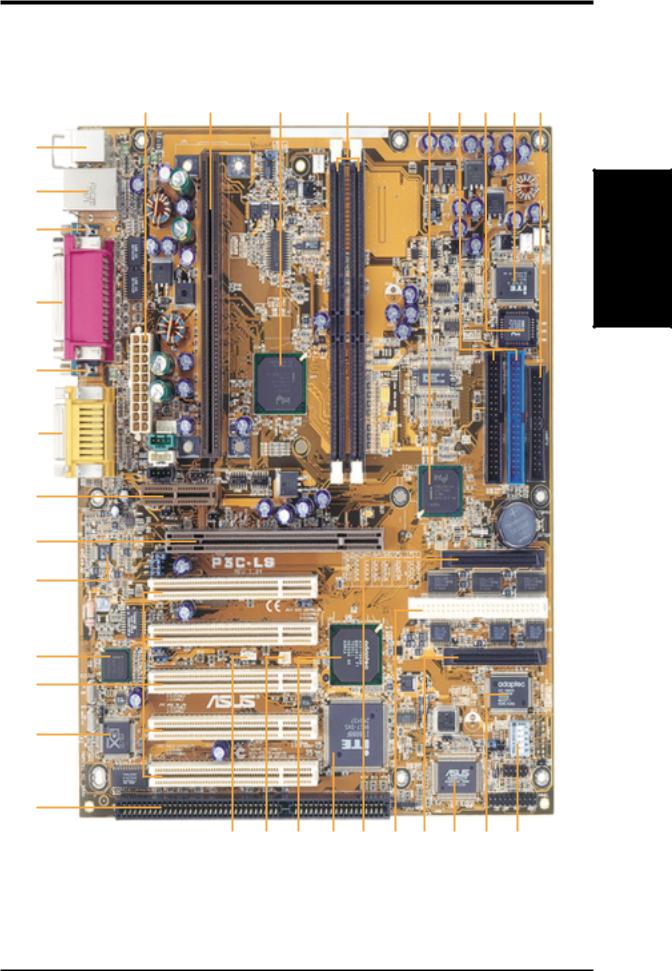
2.FEATURES
2.2Motherboard Parts...continued
1 |
2 |
3 |
4 |
5 |
6 |
7 |
8 |
9 |
32
31
30`
29
28
27
26
25
24
23
22
21
20
19 18 17 16 15 14 13 12 11 10
Motherboard Parts
2. FEA TURES
ASUS P3C-L / P3C-S / P3C-LS User’s Manual |
13 |
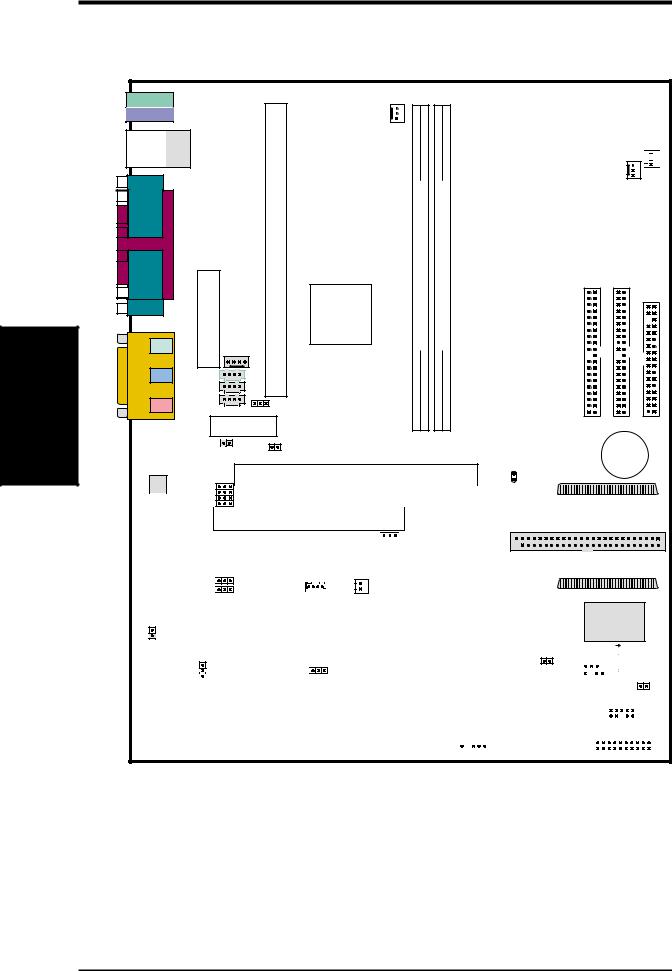
Layout Motherboard
.3 SETUP H/W
3. HARDWARE SETUP
3.1 Motherboard Layout
|
T: Mouse |
|
PS2KBMS |
|
|
|
|
|
|
||
|
B: Keyboard |
|
|
|
|
|
|
||||
|
|
|
|
|
|
|
|
|
|||
|
|
|
|
|
OPTIONAL only)45-(RJ |
|
|
CPU_FAN |
|
|
|
|
Bottom: |
|
Top: |
|
|
|
|
|
|
||
|
USB1 |
|
RJ-45 |
|
|
|
|
|
|
|
|
|
USB2 |
|
|
|
|
|
|
|
|
|
|
|
COM1 |
|
|
|
|
|
|
(16/18bit, 184-pin module) |
(16/18bit, 184-pin module) |
|
|
PARALLEL PORT |
COM2 |
|
|
Connector |
|
CPU1 (Slot 1) |
Memory |
|
|||
|
AUDIOGAME |
|
|
OPTIONAL |
|
|
|
Intel 820 |
RIMM0 |
RIMM1 |
|
|
|
|
Power |
|
|
Controller |
|
||||
|
|
|
|
|
|
|
Hub (MCH) |
|
|
|
|
|
|
|
|
|
|
|
|
|
|
|
|
|
|
Line |
|
ATX |
|
|
|
|
|
|
|
|
|
Out |
|
|
MODEM |
|
|
|
|
|
|
|
|
|
|
|
|
|
|
|
|
|
|
|
|
Line |
|
VIDEO |
|
|
|
|
|
|
|
|
|
In |
|
|
AUX |
|
|
|
|
|
|
|
|
|
|
|
|
|
|
|
|
|
|
|
|
Mic |
|
|
CD_IN |
|
|
|
|
|
|
|
|
|
|
|
|
|
|
|
|
|
|
|
|
In |
|
|
|
|
JP10 |
|
|
|
Row |
|
|
|
|
|
|
|
Audio Modem Riser |
1 2 |
3 4 |
||
|
|
|
|
|
|
|
|
|
RIMM0 RIMM1 |
||
|
|
|
|
|
SPDIFIN |
TRCPU |
|
|
|
|
|
|
|
|
|
|
|
|
|
|
|
|
|
Accelerated Graphics Port (AGP Pro)
|
|
JP4 |
|
P3C-LS / L / S |
|
|
|
JP5 |
|
|
|
Audio |
|
|
|||
Codec |
JP6 |
|
|
|
|
JP7 |
|
|
|
||
|
|
|
|
|
|
CHA_FAN
PWR_FAN 




SECONDARY IDE |
PRIMARY IDE |
FLOPPY |
|
Intel I/O |
|
|
|
|
||
|
Controller |
|
|
|
|
||
|
Hub (ICH) |
CR2032 3V |
|
|
|
||
|
|
|
|
Lithium Cell |
|
|
|
|
|
|
|
CMOS Power |
|
|
|
|
|
|
|
|
|
|
|
|
|
|
|
|
|
||
CLRTC |
35 |
|
|
68 |
|||
1 |
|
|
34 |
||||
|
|
|
|
|
|
|
|
68-Pin Ultra160 SCSI Connector
PCI Slot 1 (PCI1)
JP17




1 
|
|
|
|
|
|
PCI Slot 2 (PCI2) |
|
|
|
|
|
|
|
|
|
|
||||
|
|
|
|
|
|
|
|
Adaptec |
|
|
|
|||||||||
|
|
|
|
|
|
|
|
|
|
|
|
|
|
|||||||
|
|
|
|
JP8 |
|
|
|
|
|
|
|
|||||||||
|
Intel |
|
|
WOL_CON |
|
|
|
|
JP15 (WOR) |
7892B |
|
|
|
|||||||
|
|
|
|
|
|
|
|
|||||||||||||
|
82559 |
|
|
JP9 |
|
|
|
|
|
|||||||||||
|
|
|
|
|||||||||||||||||
|
|
|
|
|
|
|
||||||||||||||
|
10/100 |
|
|
|
|
|
|
|
|
|
|
|
Ultra160 SCSI |
|
||||||
|
LAN |
|
|
|
|
PCI Slot 3 (PCI3) |
|
|
Controller |
|
||||||||||
SPDIOOUT |
|
|
|
|
|
|
|
|
|
|
|
|
|
|||||||
|
|
|
|
|
|
|
|
|
|
|
|
|
|
|
|
|
|
|||
|
|
|
|
|
|
|
|
|
|
|
|
|
|
|
|
|
|
|
|
|
|
|
|
|
|
|
|
|
|
|
|
|
|
|
|
|
|
|
|
|
|
|
|
|
|
|
|
|
|
|
|
|
|
|
|
|
|
|
|
|
|
|
|
32-bit |
|
|
|
PCI Slot 4 (PCI4) |
|
|
PCI-to-ISA |
|
|
||||||||||
|
PCI |
|
|
|
|
|
|
|
|
|
|
|
|
|||||||
|
Audio |
|
|
|
|
|
|
|
|
|
|
Bridge |
|
|
||||||
|
Chipset |
|
|
|
|
|
JP12 |
|
|
|
|
|||||||||
|
|
|
JP2 |
|
|
|
|
|
||||||||||||
|
|
|
|
|
|
PCI Slot 5 (PCI5) |
|
|
|
|
|
|
|
|
|
|
||||
|
|
|
|
|
|
|
|
|
JP18 (SMB) |
|||||||||||
|
|
|
|
|
|
|
|
|
|
|
|
|
|
|||||||
|
|
|
|
|
|
|
|
|
|
|
|
|
|
|||||||
|
|
|
|
|
|
ISA Slot (SLOT2) |
|
|
|
|||||||||||
|
|
|
|
|
|
|
|
|
|
|
|
|
|
|
|
|||||
|
|
|
|
|
|
|
|
|
|
|
|
|
|
|
|
|
|
|
|
|
50-Pin Ultra-Fast SCSI Connector
35 |
|
68 |
1 |
|
34 |
|
|
|
|
68-Pin UltraWide SCSI Connector |
|
Adaptec
3860Q
Chipset
|
|
|
|
|
|
|
O N |
|
|
|
|
|
|
|
|
|
|
|
|
|
1 |
DIP |
|||
|
JP22 |
|
3 2 |
Switches |
||||||||
TRPWR |
|
|
|
|
|
|
4 |
|||||
|
|
|
|
|
|
5 |
|
|
|
|
||
|
CHASSIS |
|
IDELED |
|||||||||
|
|
|
|
|
|
|
|
|||||
|
|
|
|
|
|
|
IR |
|
|
|
|
|
|
ASUS |
|
|
|
|
|
|
|
|
|
|
|
|
ASIC |
|
|
|
|
|
|
|
|
|
|
|
|
with Hardware |
|
|
|
|
PANEL |
||||||
|
Monitor |
|
|
|
|
|
|
|
|
|
|
|
|
|
|
|
|
|
|
|
|
|
|
|
|
Grayed midboard items are optional at the time of purchase.
14 |
ASUS P3C-L / P3C-S / P3C-LS User’s Manual |

3.HARDWARE SETUP
3.2Layout Contents
Motherboard Settings |
|
|
|
1) |
JP22 |
p.18 |
JumperFree™ Mode (Enable/Disable) |
2) |
JP2 |
p.18 |
Audio COntroller Setting (Enable/Disable) |
3) |
JP10 |
p.19 |
Safe Mode Setting |
4) |
JP12 |
p.19 |
Automatic Timeout Reboot Setting |
5) |
AUDIO CODEC |
p.20 |
Onboard Audio Setting (Enable/Disable) |
6) |
JP17 |
p.20 |
SCSI Controller Setting (Enable/Disable) |
7) |
JP8 |
p.21 |
LAN Controller Setting (Enable/Disable) |
8) |
JP9 |
p.21 |
Wake-On-LAN Setting (Enable/Disable) |
9) |
DSW (SW2) |
p.22 |
CPU External Clock (BUS) Frequency Setting |
10) |
CLRTC |
p.63 |
Clear RTC RAM |
Expansion Slots
1) |
RIMM0, RIMM1 |
p.24 |
184-Pin System Memory Support |
2) |
CPU |
p.31 |
Central Processing Unit (CPU) |
3) |
PCI1, PCI2, PCI3, PCI4, PCI5 p.38 |
32-bit PCI Bus Expansion Slots |
|
4) |
AGPPRO |
p.40 |
Accelerated Graphics Port (AGP Pro) Slot |
5) |
AMR |
p.41 |
Audio Modem Riser (AMR) Slot |
Connectors
1) |
PS2KBMS |
p.42 |
PS/2 Mouse Connector (6-pin female) |
2) |
PS2KBMS |
p.42 |
PS/2 Keyboard Connector (6-pin female) |
3) |
USB |
p.43 |
Universal Serial Bus Ports 0 & 1 (Two 4-pin female) |
4) |
PARALLEL |
p.43 |
Parallel Port Connector (25-pin female) |
5) |
COM1, COM2 |
p.43 |
Serial Port COM1/COM2 Connectosr (Two 9-pin male) |
6) |
RJ45 |
p.43 |
Fast-Ethernet Port Connector (on LAN model only) |
7) |
GAME_AUDIO |
p.43 |
Joystick/MIDI Connector (15-pin female) (optional) |
8) |
GAME_AUDIO |
p.44 |
Audio Port Connectors (Three 1/8” female) (optional) |
9) |
CHASSIS |
p.44 |
Chassis Intrusion Connector (4-1 pins) |
10) |
PRIMARY/SECONDARYIDE p.45 |
Primary/Secondary IDE Connectors (Two 40-1pins) |
|
11) |
FLOPPY |
p.45 |
Floppy Disk Drive Connector (34-1pins) |
12) |
WOL_CON |
p.46 |
Wake-On-LAN Connector (3 pins) |
13) |
WOR |
p.46 |
Wake-On-Ring Connector (2 pins) |
14) |
IDELED |
p.47 |
IDE Activity LED (2 pins) |
Layout Contents
3. H/W SETUP
ASUS P3C-L / P3C-S / P3C-LS User’s Manual |
15 |

Layout |
H/W.3 |
Contents |
SETUP |
3. HARDWARE SETUP
15) |
CPU_Fan, PWR_FAN |
p.47 |
CPU, Power Supply, Chassis Fan Connectors (Four 3-pin) |
|
CHA_FAN |
|
|
16) |
MODEM, VIDEO, AUX |
p.48 |
Internal Audio Connectors (Four 4-pins) (optional) |
17) |
IR |
p.48 |
Serial Infrared Module Connector (5-pin) |
18) |
SPDIFIN, SPDIOOUT |
p.49 |
Digital Audio Interface Header (Two 2-pin) |
19) |
ATXPWR |
p.49 |
ATX Power Supply Connectors (20 pins) |
20) |
SMB |
p.50 |
SMBus Connector (3-pin) (optional) |
21) |
J1, J2, J3 |
p.50 |
Ultra-Fast (50-pin)/Ultra2 (68-pin) SCSI connectors |
22) |
PLED (PANEL) |
p.52 |
System Power LED Lead (3-1 pins) |
23) |
KEYLOCK (PANEL) |
p.52 |
Keyboard Lock Switch Lead (2 pins) |
24) |
SPEAKER (PANEL) |
p.52 |
System Warning Speaker Connector (4 pins) |
25) |
LED (PANEL) |
p.52 |
System Message LED (2 pins) |
26) |
SMI (PANEL) |
p.52 |
System Management Interrupt Switch Lead (2 pins) |
27) |
PWRSW (PANEL) |
p.52 |
ATX Power / Soft-Off Switch Lead (2 pins) |
28) |
RESET (PANEL) |
p.52 |
Reset Switch Lead (2 pins) |
16 |
ASUS P3C-L / P3C-S / P3C-LS User’s Manual |
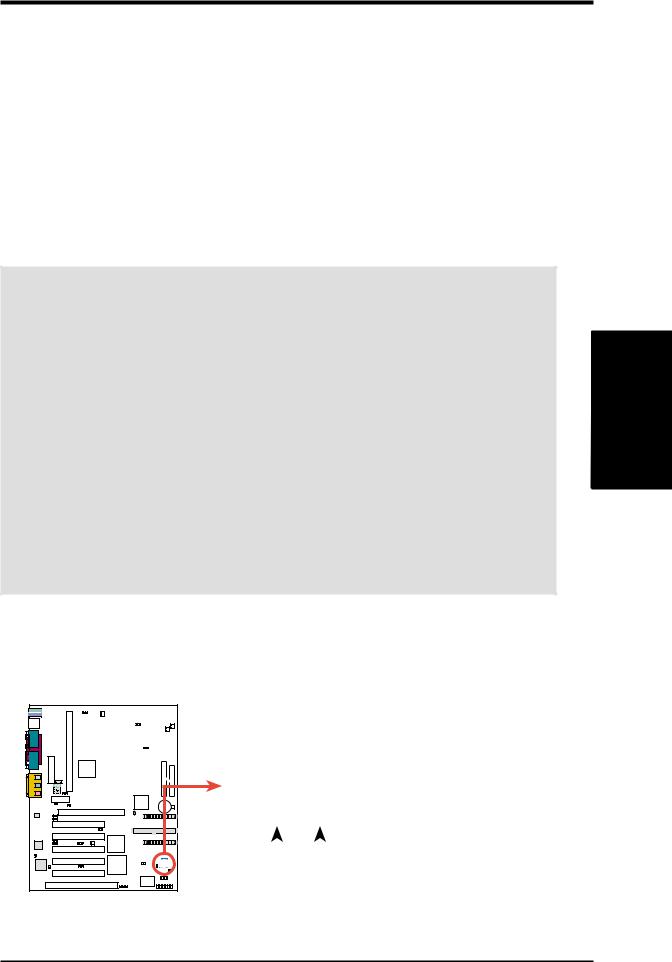
3.HARDWARE SETUP
3.3Hardware Setup Procedure
Before using your computer, you must complete the following steps:
•Check Motherboard Settings
•Install Memory Modules
•Install the Central Processing Unit (CPU)
•Install Expansion Cards
•Connect Ribbon Cables, Panel Wires, and Power Supply
3.4Motherboard Settings
WARNING! Computer motherboards and expansion cards contain very delicate Integrated Circuit (IC) chips. To protect them against damage from static electricity, you should follow some precautions whenever you work on your computer.
1.Unplug your computer when working on the inside.
2.Use a grounded wrist strap before handling computer components. If you do not have one, touch both of your hands to a safely grounded object or to a metal object, such as the power supply case.
3.Hold components by the edges and try not to touch the IC chips, leads or connectors, or other components.
4.Place components on a grounded antistatic pad or on the bag that came with the component whenever the components are separated from the system.
5.Ensure that the ATX power supply is switched off before you plug in or remove the ATX power connector on the motherboard.
Motherboard Feature Settings
The motherboard’s onboard functions are either adjusted through jumpers or DIP switches. When using DIP switches, the white block represents the switch’s position. The example below shows all the switches in the OFF position.
P3C-LS / L / S
|
|
|
|
|
|
|
|
|
|
|
|
|
|
|
|
|
|
|
|
|
|
|
|
|
|
|
|
|
|
|
|
|
|
|
|
|
|
|
|
|
|
|
|
|
|
|
|
|
|
|
|
|
|
|
|
|
|
|
|
|
|
|
|
|
|
|
|
|
|
|
|
|
|
|
|
|
|
|
|
|
|
|
|
|
|
|
|
|
|
|
|
|
|
|
|
|
|
|
|
|
|
|
|
|
|
|
|
|
|
|
|
|
|
|
|
|
|
DSW |
2 1 |
|
|
ON |
|
||
|
|
|
|
|
|
|
|
|
|
|
|
|
|||||
|
|
|
|
|
|
|
|
|
|
|
|
||||||
|
|
|
|
|
|
|
|
|
|
|
|
|
|||||
|
|
|
|
|
|
|
|
|
|
(D21) |
3 |
|
|
|
|
|
|
|
|
|
|
|
|
|
|
|
|
|
|
|
|
|
|
||
|
|
|
|
|
|
|
|
|
|
|
4 |
|
|
|
|
|
|
|
|
|
|
|
|
|
|
|
|
|
5 |
|
|
|
|
|
|
|
|
|
|
|
|
|
|
|
|
|
|
|
|
|
|
||
|
|
|
|
|
|
|
|
|
|
|
|
|
|
|
|
|
|
|
|
|
|
|
|
|
|
|
|
|
|
|
|
|
|
|
|
|
|
|
|
|
|
|
|
|
|
|
|
|
|
|
|
|
|
|
|
|
|
|
|
|
|
|
|
|
OFF |
|
|
ON |
|
||
|
|
|
|
|
|
|
|
|
|
|
|
|
|
||||
|
|
|
|
|
|
|
|
|
|
|
|
|
|
||||
|
|
|
|
|
|
|
|
|
|
|
|
|
|
||||
|
|
|
|
|
|
|
|
|
|
|
|
|
|
|
|
||
1.Frequency Selection
2.Frequency Selection
3.Frequency Selection
4.Frequency Selection
5.Frequency Selection
P3C-LS/L/S DIP Switches
.3 SETUPH/W
Motherboard Settings
ASUS P3C-L / P3C-S / P3C-LS User’s Manual |
17 |
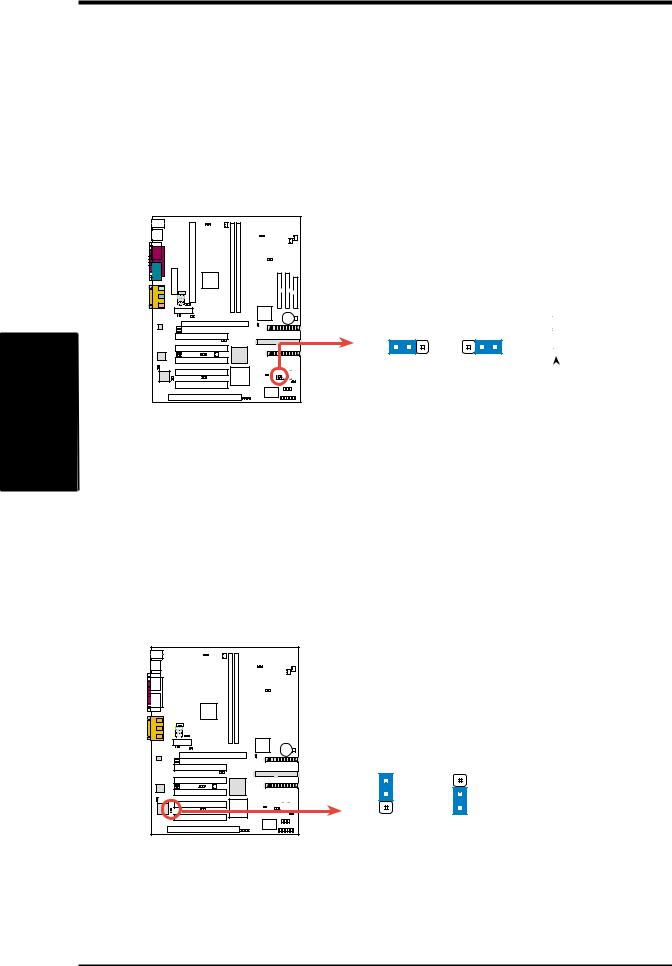
SETUP H/W .3
Settings Motherboard
3.HARDWARE SETUP
1)JumperFree™ Mode (JP22)
This jumper |
allows you to enable or disable the JumperFree™ mode. The |
JumperFree™ |
mode allows processor settings to be made through the BIOS |
setup (see 4.4 Advanced Menu). |
|
NOTE: In JumperFree™ mode, all dip switches (DSW) must be set to OFF. |
|
Setting |
|
JP22 |
||||||
Enable (JumperFree) |
|
[1-2] (default) |
||||||
Disable (Jumper) |
[2-3] |
|||||||
|
|
|
|
|
|
|
|
|
|
|
|
|
|
|
|
|
|
|
|
|
|
|
|
|
|
|
|
|
|
|
|
|
|
|
|
|
|
|
|
|
|
|
|
|
|
|
|
|
|
|
|
|
|
|
|
|
|
|
|
|
|
|
|
|
|
JP22 |
|
|
|
P3C-LS / L / S |
1 |
2 |
3 |
1 |
2 |
3 |
|
||||||
|
JumperFree |
Jumper |
||||
P3C-LS/L/S JumperFree™ Mode Setting
DSW
(D21)
|
2 1 |
|
|
ON |
|
|
|
|
|
||
|
|
|
|
||
|
|
|
|
||
|
3 |
|
|
|
|
|
|
|
|
|
|
|
4 |
|
|
|
|
|
|
|
|
|
|
|
5 |
|
|
|
|
|
|
|
|
|
|
|
|
|
|
|
|
|
|
|
|
|
|
OFF
(JumperFree Mode)
2)Audio Controller Setting (JP2) (on model with onboard PCI audio)
This jumper allows you to enable or disable the onboard 32-bit PCI audio controller (optional component). Disable the onboard audio if you are using a PCI audio card on any of the expansion slots or a primary AMR on the AMR slot (see 3.7.3 Audio Modem Riser (AMR) Slot).
Setting |
|
JP2 |
||||||||||||||
Enable |
|
[1-2] (default) |
||||||||||||||
Disable |
[2-3] |
|
|
|
|
|
|
|
||||||||
|
|
|
|
|
|
|
|
|
|
|
|
|
|
|
|
|
|
|
|
|
|
|
|
|
|
|
|
|
|
|
|
|
|
|
|
|
|
|
|
|
|
|
|
|
|
|
|
|
|
|
|
|
|
|
|
|
|
|
|
|
|
|
|
|
|
|
|
|
|
|
|
|
|
|
|
|
|
|
|
|
|
|
|
|
|
|
|
|
|
|
|
|
|
|
|
|
|
|
|
|
|
|
|
|
|
|
|
|
|
|
|
|
|
|
|
|
|
|
|
|
|
|
|
|
|
|
|
|
|
|
|
|
|
|
|
|
|
|
|
|
|
|
|
|
|
|
|
|
|
|
|
|
|
|
|
|
|
|
|
|
|
|
|
|
|
|
|
|
|
|
|
|
|
|
|
|
|
|
|
|
|
|
|
|
|
|
|
|
|
|
|
|
|
|
|
|
|
|
|
|
|
|
|
P3C-LS / L / S |
|
JP2 |
1 |
1 |
2 |
2 |
3 |
3 |
Enable |
Disable |
P3C-LS/L/S Audio Controller Setting
18 |
ASUS P3C-L / P3C-S / P3C-LS User’s Manual |
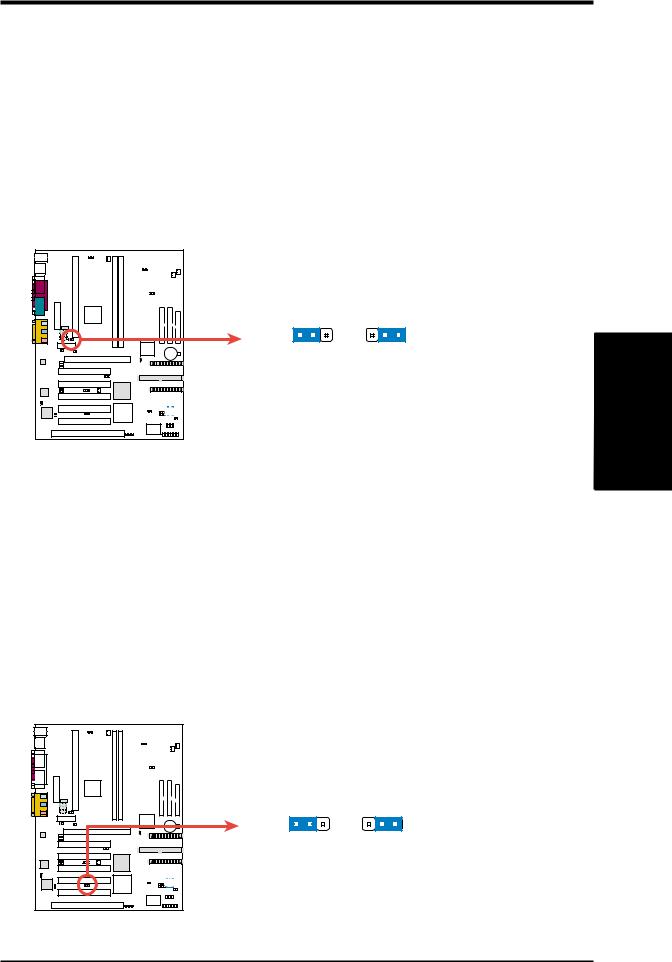
3.HARDWARE SETUP
3)Safe Mode Setting (JP10)
Usually Slot 1 processors have locked frequency multiples. In this case, there is no way to exceed the specified multiple whether through motherboard settings or BIOS setup. With unlocked Slot 1 processors, exceeding the specified multiple is possible through BIOS setup. Exceeding the specified multiple may result in hanging during bootup. If this occurs, enable Safe Mode to force a multiple of 2 and 100MHz FSB to enter BIOS setup to correct the problem.
Setting JP10
Normal |
|
[1-2] (default) |
||||||
Safe Mode |
[2-3] |
|
|
|
||||
|
|
|
|
|
|
|
|
|
|
|
|
|
|
|
|
|
|
|
|
|
|
|
|
|
|
|
|
|
|
|
|
|
|
|
|
|
|
|
|
|
|
|
|
|
|
|
|
|
|
|
|
|
|
|
|
|
|
|
|
|
|
|
P3C-LS / L / S |
JP10
1 |
2 |
3 |
1 |
2 |
3 |
Normal |
Safe Mode |
||||
(Default) |
|
|
|
||
P3C-LS/L/S Safe Mode Reboot Setting
4)Automatic Timeout Reboot Setting (JP12)
The motherboard is set so that when the BIOS detects a hang (timeout) during bootup, the motherboard will automatically reboot. If rebooting is repeating ineffectively, set this jumper to No Reboot to disable auto-reboot. However, if
Safe Mode Setting (JP10) is set to Safe Mode, setting Automatic Timeout Reboot Setting (JP12) to No Reboot will bring the system to Safe Mode so you may correct any problem.
Setting |
|
JP12 |
|||||
Normal |
|
[1-2] (default) |
|||||
No Reboot |
[2-3] |
|
|
|
|||
|
|
|
|
|
|
|
|
|
|
|
|
|
|
|
|
|
|
|
|
|
|
|
|
|
|
|
|
|
|
|
|
|
|
|
|
|
|
|
|
|
|
|
|
|
|
|
|
|
|
|
|
|
|
|
|
|
|
|
|
|
|
|
|
|
|
|
|
|
|
|
|
P3C-LS / L / S |
JP12
1 |
2 |
3 |
1 |
2 |
3 |
Normal |
No Reboot |
||||
(Default) |
|
|
|
||
P3C-LS/L/S Automatic Timeout Reboot Setting
.3 SETUPH/W
Motherboard Settings
ASUS P3C-L / P3C-S / P3C-LS User’s Manual |
19 |
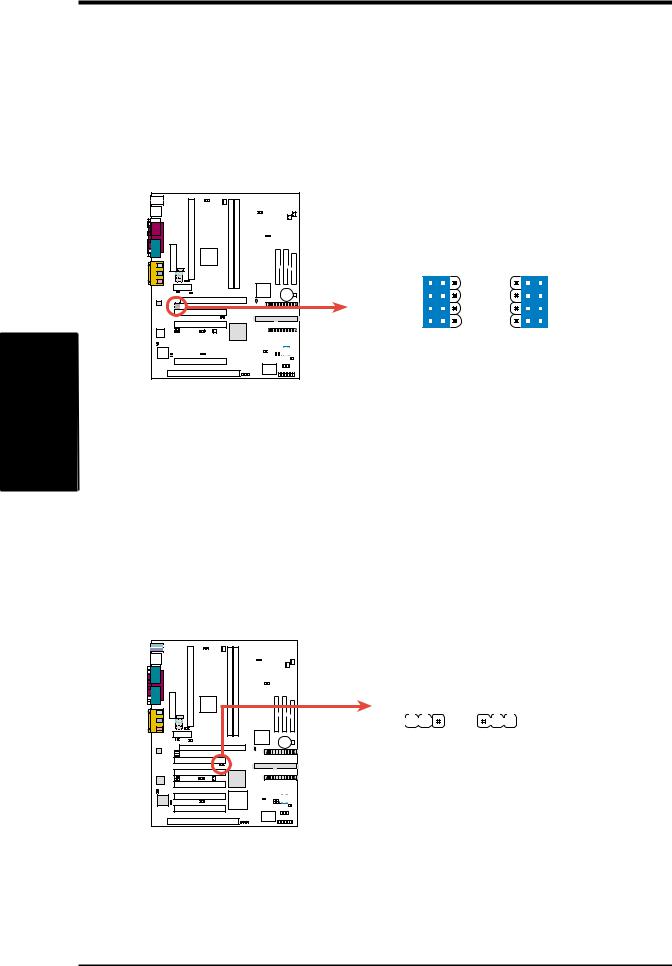
SETUP H/W .3
Settings Motherboard
3.HARDWARE SETUP
5)Onboard Audio Setting (available on software audio model only)
The onboard audio CODEC may be enabled or disabled using all of these jumpers. Disable the onboard audio CODEC if you are using a primary AMR on the AMR slot (see AMR Slot later in this section).
Setting |
|
AUDIO CODEC |
||||||
Enable |
|
[1-2] [1-2] [1-2] [1-2] (Default) |
||||||
Disable |
[2-3] [2-3] [2-3] [2-3] |
|||||||
|
|
|
|
|
|
|
|
|
|
|
|
|
|
|
|
|
|
|
|
|
|
|
|
|
|
|
|
|
|
|
|
|
|
|
|
|
|
|
|
|
|
|
|
|
|
|
|
|
|
|
|
|
|
|
|
|
|
|
|
|
|
|
JP4=SPK |
|
|
JP5=AUD_EN1 |
|
JP4–JP7 |
JP6=AUD_EN2 |
|
|
JP7=ADN# |
1 |
1 |
|
JP4 |
JP4 |
JP5 |
JP5 |
P3C-LS / L / S |
JP6 |
JP6 |
|
JP7 |
JP7 |
|
|
|
|
|
|
|
|
|
|
|
|
|
Enable |
Disable |
|
|
|
|
|
|
|
|
|
|
|
|
|
||
|
|
|
|
|
|
|
|
|
|
|
|
|
||
|
|
|
|
|
|
|
|
|
|
|
|
|
Onboard |
Onboard |
|
|
|
|
|
|
|
|
|
|
|
|
|
Audio CODEC |
Audio CODEC |
|
|
|
|
|
|
|
|
|
|
|||||
|
|
|
|
|
|
|
|
|
|
|
|
(Default)
P3C-LS/L/S Audio CODEC Setting
6)SCSI Controller Setting (JP17) (available on SCSI models only)
This jumper lets you disable or enable the SCSI controller function. Set to Disable if you do not want to use the onboard SCSI controller. The default setting is Enable, which lets you use the onboard SCSI controller.
Setting JP17
Enable |
[2-3] (default) |
Disable [1-2]
P3C-LS / L / S |
P3C-LS/L/S SCSI Controller Setting
JP17
1 |
2 |
3 |
1 |
2 |
3 |
|
|
|
|
|
|
Disable Enable
(Default)
20 |
ASUS P3C-L / P3C-S / P3C-LS User’s Manual |
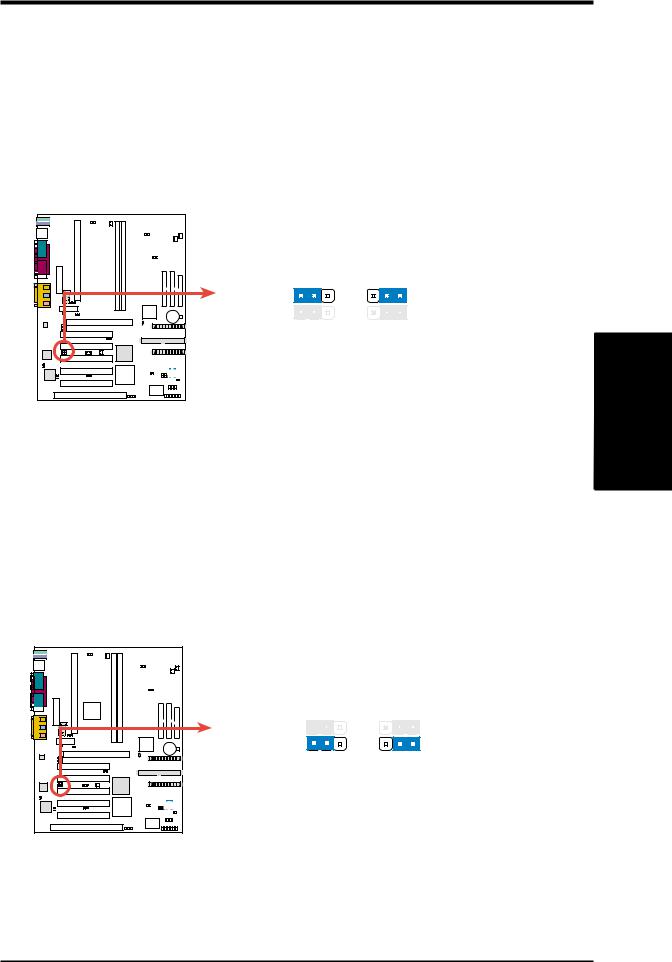
3.HARDWARE SETUP
7)LAN Controller Setting (JP8) (available on LAN models only)
This jumper lets you disable or enable the LAN controller function. Set to Disable if you do not want to use the onboard LAN controller. The default setting is Enable, which lets you use the onboard LAN controller.
Setting JP8
Enable |
[1-2] (default) |
Disable [2-3]
JP8
|
|
|
|
Enable |
|
|
|
||
|
|
|
|
||||||
|
|
|
|
(Default) |
Disable |
||||
|
|
|
|
||||||
|
|||||||||
|
|
|
|
1 |
2 |
3 |
1 |
2 |
3 |
JP8 |
JP9 |
P3C-LS / L / S
P3C-LS/L/S LAN Controller Setting
8)Wake-On-LAN Controller Setting (JP9) (available on LAN models only) This jumper lets you disable or enable the Alert-On-LAN and Wake-On-LAN support of the onboard LAN controller. The default setting is Enable, which lets you use the Alert-On-LAN and Wake-On-LAN support of the LAN controller.
Setting JP9
Enable |
[2-3] (default) |
Disable [1-2]
JP9
|
|
|
1 |
2 |
3 |
1 |
2 |
3 |
JP8 |
JP9 |
P3C-LS / L / S |
Disable |
Enable |
|
|
(Default) |
P3C-LS/L/S Wake-On-LAN Controller Setting
.3 SETUPH/W
Motherboard Settings
ASUS P3C-L / P3C-S / P3C-LS User’s Manual |
21 |
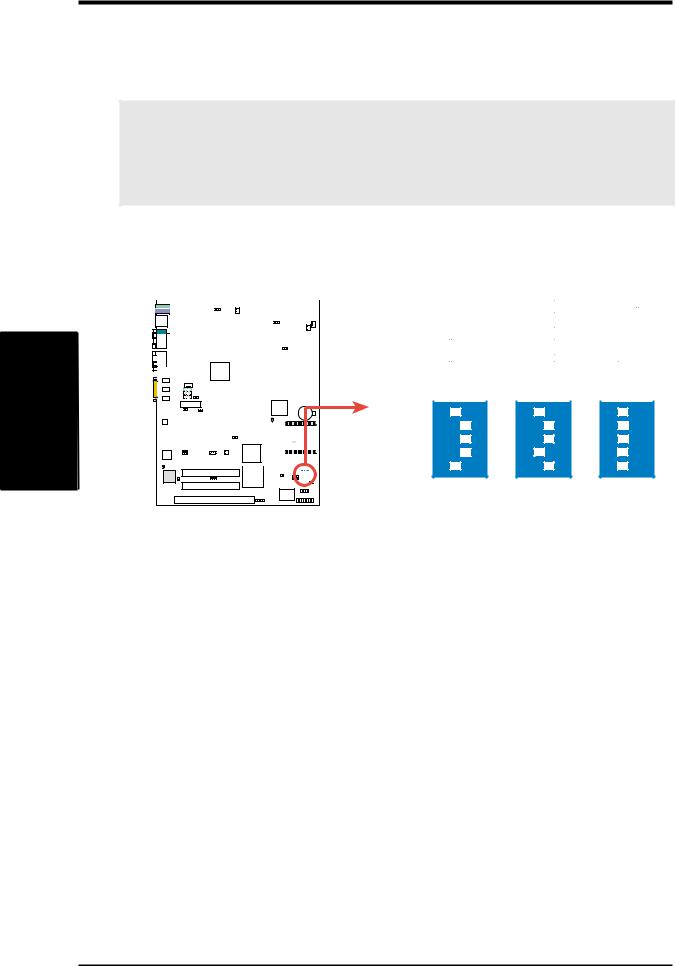
SETUP H/W .3
Settings Motherboard
3.HARDWARE SETUP
9)CPU External Frequency (FSB) Setting (DSW-1, -2, -3, -4, -5)
This option tells the clock generator what frequency to send to the CPU and the PCI bus. This allows the selection of the CPU’s External frequency.
IMPORTANT:
1.In JumperFree mode, all dip switches (DSW-1–DSW-5) must be set to OFF.
2.When JumperFree mode is enabled, use BIOS setup in place of these switches (see CPU Speed in Advanced Menu in BIOS Setup).
NOTE: Only selected switches are illustrated. For a complete frequency listing, see next page.
|
|
|
|
|
|
|
|
|
|
|
|
|
|
|
|
|
|
|
|
|
|
|
DSW |
|
|
ON |
|
|
|
|
|
ON |
|
2 1 |
|
|
ON |
|
|
|
|
|
|
|
|
|
|
|
|
|
|
|
|
|
|
|
|
|
|
|
|
|
|
|
|
|
|
|
|
|
|
|
|
||||||
|
|
|
|
|
|
|
|
|
|
|
|
|
|
|
|
|
|
|
|
|
|
|
(D21) |
|
21 |
|
|
21 |
|
|
|
|
|
|
|||||
|
|
|
|
|
|
|
|
|
|
|
|
|
|
|
|
|
|
|
|
|
|
|
|
|
|
|
|
|
|
|
|
||||||||
|
|
|
|
|
|
|
|
|
|
|
|
|
|
|
|
|
|
|
|
|
|
|
|
|
3 |
|
|
|
|
3 |
|
|
|
|
3 |
|
|
|
|
|
|
|
|
|
|
|
|
|
|
|
|
|
|
|
|
|
|
|
|
|
|
|
|
|
4 |
|
|
|
|
4 |
|
|
|
|
4 |
|
|
|
|
|
|
|
|
|
|
|
|
|
|
|
|
|
|
|
|
|
|
|
|
|
|
|
|
|
|
|
|
|
|
|
|
|
|
|
|
|
|||
|
|
|
|
|
|
|
|
|
|
|
|
|
|
|
|
|
|
|
|
|
|
|
FSB |
→ |
5 |
|
|
|
|
5 |
|
|
|
|
5 |
|
|
|
|
|
|
|
|
|
|
|
|
|
|
|
|
|
|
|
|
|
|
|
|
|
|
|
|
|
|
|
|
|
|
|
|
|
|
|
|||||
|
|
|
|
|
|
|
|
|
|
|
|
|
|
|
|
|
|
|
|
|
|
|
|
|
|
|
|
|
|
|
|
|
|
|
|
|
|
||
|
|
|
|
|
|
|
|
|
|
|
|
|
|
|
|
|
|
|
|
|
|
|
100.9MHz |
|
103MHz |
|
105MHz |
|
|||||||||||
|
|
|
|
|
|
|
|
|
|
|
|
|
|
|
|
|
|
|
|
|
|
|
|
|
|
|
|||||||||||||
|
|
|
|
|
|
|
|
|
|
|
|
|
|
|
|
|
|
|
|
|
|
|
|
|
|
|
|||||||||||||
|
|
|
|
|
|
|
|
|
|
|
|
|
|
|
|
|
|
|
|
|
|
|
|
|
|
|
|
|
|
|
|
|
|
|
|
|
|
|
|
|
|
|
|
|
|
|
|
|
|
|
|
|
|
|
|
|
|
|
|
|
|
|
|
|
|
|
|
|
|
|
|
|
|
|
|
|
|
|
|
|
|
|
|
|
|
|
|
|
|
|
|
|
|
|
|
|
|
|
|
|
|
|
|
|
|
|
|
|
|
|
|
|
ON |
|
|
|
|
|
|
|
|
|
|
|
|
|
|
|
|
|
|
|
|
|
|
|
|
|
|
|
|
|
|
2 1 |
|
ON |
2 1 |
|
|
2 1 |
|
|
ON |
|
|||||
|
|
|
|
|
|
|
|
|
|
|
|
|
|
|
|
|
|
|
|
|
|
|
|
|
|
|
|
|
|
||||||||||
|
|
|
|
|
|
|
|
|
|
|
|
|
|
|
|
|
|
|
|
|
|
|
|
|
|
|
|
|
|
||||||||||
|
|
|
P3C-LS / L / S |
|
|
|
|
|
|
|
|
|
|
|
|
|
|
|
|
|
|
|
|
|
|
||||||||||||||
|
|
|
|
|
|
|
|
|
|
|
|
|
|
|
|
|
|
|
|
|
|
|
|
3 |
|
|
|
|
3 |
|
|
|
3 |
|
|
|
|
||
|
|
|
|
|
|
|
|
|
|
|
|
|
|
|
|
|
|
|
|
|
|
|
|
|
|
|
|
|
|
|
|
|
|
|
|||||
|
|
|
|
|
|
|
|
|
|
|
|
|
|
|
|
|
|
|
|
|
|
|
|
4 |
|
|
|
|
4 |
|
|
|
4 |
|
|
|
|
||
|
|
|
|
|
|
|
|
|
|
|
|
|
|
|
|
|
|
|
|
|
|
|
|
|
|
|
|
|
|
|
|
|
|
|
|||||
|
|
|
|
|
|
|
|
|
|
|
|
|
|
|
|
|
|
|
|
|
|
|
|
5 |
|
|
|
|
5 |
|
|
|
5 |
|
|
|
|
||
|
|
|
|
|
|
|
|
|
|
|
|
|
|
|
|
|
|
|
|
|
|
|
|
|
|
|
|
|
|
|
|
|
|
|
|
|
|
|
|
FSB |
→ |
133.9MHz |
138MHz |
(JumperFree Mode) |
P3C-LS/L/S CPU External Clock
(BUS) Frequency Selection
NOTE: If your processor does not have a locked Frequency Multiple, you must use CPU Core:Bus Freq. Multiple in 4.4 Advanced Menu of the BIOS setup to set the Frequency Multiple. If the Frequency Multiple is locked, setting the Frequency Multiple in BIOS setup will have no effect.
22 |
ASUS P3C-L / P3C-S / P3C-LS User’s Manual |

3. HARDWARE SETUP
External Frequency Table
The following table is for use by experienced motherboard installers only. Overclocking can result in system instability or even shortening the life of the processor.
FSB |
Frequency Selection Switches |
||||
(MHz) |
1 |
2 |
3 |
4 |
5 |
|
|
|
|
|
|
103.0 |
[O N ] |
[O N ] |
[O N ] |
[O N ] |
[O N ] |
105.0 |
[O N ] |
[O N ] |
[O N ] |
[O N ] |
[OFF] |
100.9 |
[O N ] |
[O N ] |
[O N ] |
[OFF] [OFF] |
|
107.0 |
[O N ] |
[O N ] |
[OFF] |
[O N ] |
[O N ] |
109.0 |
[O N ] |
[O N ] |
[OFF] |
[O N ] |
[OFF] |
112.0 |
[O N ] |
[O N ] |
[OFF] |
[OFF] |
[O N ] |
114.0 |
[O N ] |
[O N ] |
[OFF] |
[OFF] |
[OFF] |
116.1 |
[O N ] |
[OFF] |
[O N ] |
[O N ] |
[O N ] |
118.0 |
[O N ] |
[OFF] |
[O N ] |
[O N ] |
[OFF] |
120.0 |
[O N ] |
[OFF] |
[O N ] |
[OFF] |
[OFF] |
122.0 |
[O N ] |
[OFF] |
[OFF] |
[O N ] |
[O N ] |
125.1 |
[O N ] |
[OFF] |
[OFF] |
[O N ] |
[OFF] |
128.2 |
[O N ] |
[OFF] |
[OFF] |
[OFF] |
[O N ] |
130.0 |
[O N ] |
[OFF] |
[OFF] |
[OFF] |
[OFF] |
133.9 |
[OFF] [O N ] |
[O N ] |
[O N ] [OFF] |
||
138 |
[OFF] [O N ] |
[O N ] [OFF] [O N ] |
|||
142 |
[OFF] |
[O N ] |
[O N ] |
[OFF] |
[OFF] |
146 |
[OFF] |
[O N ] |
[OFF] |
[O N ] |
[O N ] |
150 |
[OFF] |
[O N ] |
[OFF] |
[O N ] |
[OFF] |
153 |
[OFF] |
[O N ] |
[OFF] |
[OFF] |
[O N ] |
156 |
[OFF] |
[O N ] |
[OFF] |
[OFF] |
[OFF] |
159.1 |
[OFF] |
[OFF] |
[O N ] |
[O N ] |
[O N ] |
162 |
[OFF] |
[OFF] |
[O N ] |
[O N ] |
[OFF] |
165 |
[OFF] |
[OFF] |
[O N ] |
[OFF] |
[O N ] |
168 |
[OFF] |
[OFF] |
[O N ] |
[OFF] |
[OFF] |
171 |
[OFF] |
[OFF] |
[OFF] |
[O N ] |
[O N ] |
174 |
[OFF] |
[OFF] |
[OFF] |
[O N ] |
[OFF] |
177 |
[OFF] |
[OFF] |
[OFF] |
[OFF] |
[O N ] |
180 |
[OFF] |
[OFF] |
[OFF] |
[OFF] |
[OFF] |
|
|
|
|
|
|
NOTE: For updated processor settings, visit the ASUS web site (see ASUS CONTACT INFORMATION)
.3 SETUPH/W
Motherboard Settings
ASUS P3C-L / P3C-S / P3C-LS User’s Manual |
23 |

Memory System
H/W .3 SETUP
3.HARDWARE SETUP
3.5System Memory
NOTE: No hardware or BIOS setup is required after adding or removing memory.
This motherboard has two Rambus Inline Memory Module (RIMM) sockets. These sockets (see Important notes for details) support Direct RDRAMs (both ECC and non-ECC are supported) in 64, 96, 128, 192, 256, and 512MB densities for a maximum of 1GB.
With the optional ASUS DR2 DIMM Riser, unbuffered Synchronous Dynamic Random Access Memory (SDRAM, 3.3V power level) in 64, 128, 256, or 512MB densities with Serial Presence Detect (SPD) can also be used on the second socket for a maximum of 1GB.
The chipset’s Error Checking and Correction (ECC) feature is available only when using RDRAMs. ECC feature is not available when using SDRAM with an ASUS DIMM Riser (ECC memory modules may still be used, but the ECC function will not be available).
For memory speed setup, see 4.4.1 CHIP Configuration.
IMPORTANT
General
1. DO NOT attempt to mix RDRAMs with an SDRAM+Riser or vice versa.
RDRAM
1.If more than one socket will be populated with RDRAMs, RIMM0 must be populated first and then RIMM1. If only one socket will be populated, RIMM0 must be populated with RDRAM, RIMM1 with C-RIMM. See table for an overview.
SDRAM
1.To use SDRAM with this motherboard, an ASUS DR2 DIMM Riser must be installed as an interface (see 3.5.2 Installing Memory Using theASUS DR2 DIMM Riser). The riser must (and can only) be inserted into RIMM0, with the bundled C-RIMM inserted into RIMM1. See table for an overview.
2.When populating both DIMM sockets in the riser, the module density on J1M2 must be greater than the one on J1M1.
3.This motherboard’s chipset only supports 64Mbit and 128Mbit SDRAMs (see SDRAM Configurations). 32Mx4 128 Mbit support is for registered DIMMs only. 4Mx16 64 Mbit support is for unbufferred DIMMs only.
C-RIMM/CTRIMM
1.Depending on your configuration, a C-RIMM (Continuity RIMM) must be used to complete the sockets that are not populated by either RDRAMs or an ASUS DIMM Riser (when using SDRAM). C-RIMM is necessary to avoid breaking the signal lines, which are a serial connection in a Rambus interface, such as used in this motherboard. The C-RIMM assures the electrical integrity of a Rambus interface.
24 |
ASUS P3C-L / P3C-S / P3C-LS User’s Manual |

3. HARDWARE SETUP
SDRAM Configurations
Technology |
Configuration |
No. of Row |
No. of Col. |
No. of Bank |
Page |
|
|
Address Bits |
Address Bits |
Address Bits |
Size |
|
|
|
|
|
|
64Mbit |
8Mx8 |
12 |
9 |
2 |
4KB |
|
|
|
|
|
|
64Mbit |
4Mx16 |
12 |
8 |
2 |
2KB |
|
|
|
|
|
|
128Mbit |
32Mx4 |
12 |
11 |
2 |
16KB |
|
|
|
|
|
|
128Mbit |
16Mx8 |
12 |
10 |
2 |
8KB |
|
|
|
|
|
|
Install memory in any of the following combinations (see following pages for installation procedures):
RDRAM
Current |
RIMM0 |
RIMM1 |
Memory |
|
|
|
|
|
1 RDRAM |
RIMM |
C-RIMM |
2 RDRAMs |
RIMM |
RIMM |
SDRAM/s* |
DIMM Riser* |
C-RIMM |
|
|
|
*SDRAM with an ASUS DR2 DIMM Riser (see Important SDRAM notes in opposite page)
Current |
J1M1 |
J1M2 |
Notes on |
Memory |
(Rows 0&1) |
(Rows 2&3) |
memory size |
|
|
|
|
1 SDRAM |
SDRAM |
(empty) |
— |
2 SDRAMs |
SDRAM |
SDRAM |
J1M2J1M1 |
|
|
|
|
.3 SETUPH/W
System Memory
ASUS P3C-L / P3C-S / P3C-LS User’s Manual |
25 |
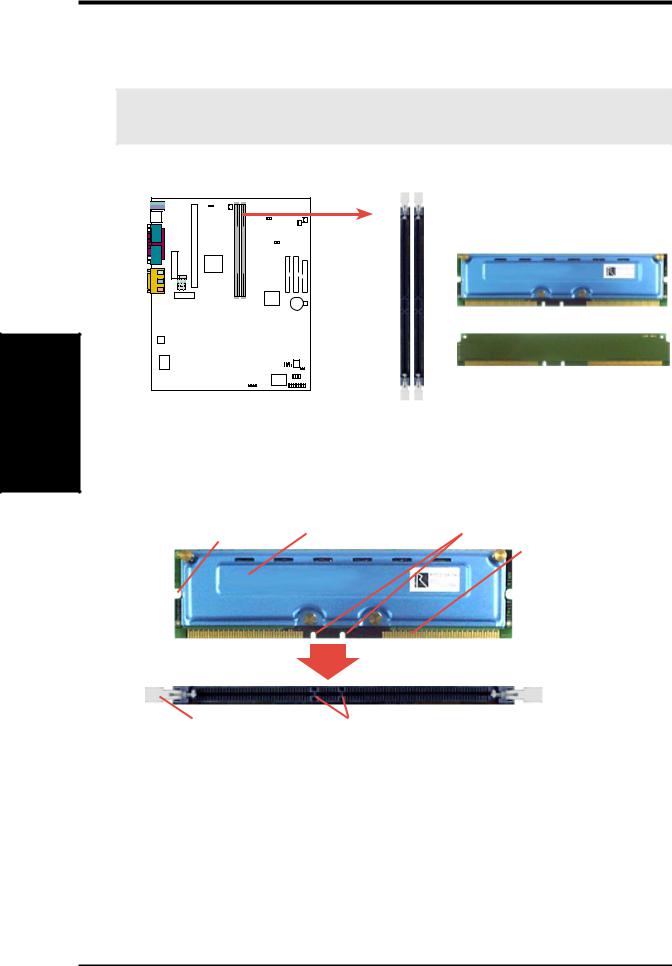
Memory System
H/W .3 SETUP
3.HARDWARE SETUP
3.5.1Installing Memory Using RIMM/C-RIMM
The memory module (RIMM/C-RIMM) will fit in only one orientation.
IMPORTANT: Do not touch the memory module’s connectors. Handle the module only by the edges.
RIMM0 RIMM1
RIMM Sockets
OPTIONAL
PARALLEL PORT
1 2 |
3 4 |
|
|
|
|
|
|
|
|
|
|
|
RIMM with Heat Spreader |
|
|
|
|
|
P3C-LS / L / S |
|
|
|
|
|
|
|
|
|
|
|
|
|
|
|
|
|
C-RIMM |
|
|
|
|
|
|
|
|
|
|
|
|
|
|
|
|
|
|
|
|
|
|
|
|
|
|
|
|
|
|
|
|
|
|
|
|
|
|
|
|
|
|
|
|
|
|
|
|
|
|
|
|
|
|
|
|
|
|
|
|
|
|
|
|
|
|
|
|
|
|
|
|
|
|
|
|
|
|
|
|
|
|
|
|
|
|
|
|
|
|
|
|
|
|
|
|
|
|
|
|
|
|
|
|
|
|
|
|
|
|
|
|
|
|
|
|
|
|
|
|
|
|
|
|
|
|
|
|
|
|
|
|
P3C-LS/L/S 184-Pin RIMM Sockets
1.Make sure that the notch keys in the module are aligned with the small ribs inside the RIMM sockets.
MOUNTING NOTCH |
RDRAM (with heat spreader) |
NOTCH KEYS |
CONNECTORS
(TOP VIEW)
EJECTOR |
RIBS (inside socket) |
2.With the ejectors in the open position (as shown), push down gently but firmly on the memory module until it snaps into place. The guides on the socket’s ejectors should go through the two mounting notches on the module and the ejectors should close. If necessary, push the ejectors inward to secure the module in place.
Removing Memory
1.To release a memory module, push both ejectors outward and pull the module straight up and out of the RIMM sockets.
26 |
ASUS P3C-L / P3C-S / P3C-LS User’s Manual |
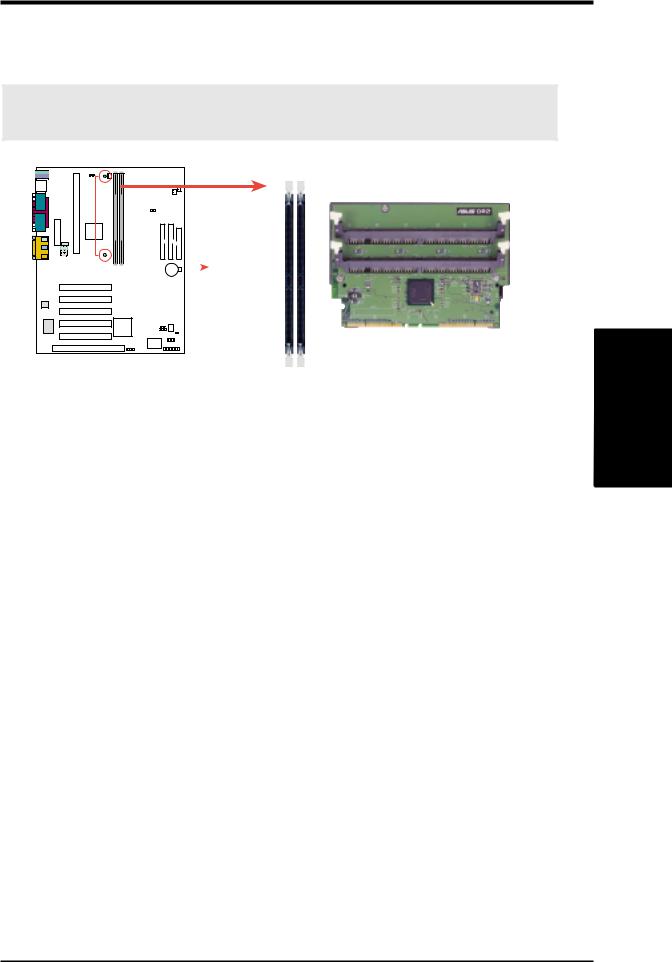
3.HARDWARE SETUP
3.5.2Installing Memory Using an ASUS DIMM Riser
The ASUS DIMM Riser will fit in only one orientation.
IMPORTANT: Do not touch the riser’s connectors. Handle the riser only by the edges.
RIMM0 RIMM1
OPTIONAL
PARALLEL PORT
|
|
|
|
1 2 |
3 4 |
|
|
|
|
|
ATTACH MOUNT |
||
|
|
|
|
|
|
|
|
|
|
|
|
|
BRIDGES |
|
|
|
|
|
|
|
|
|
|
|
|
|
|
P3C-LS / L / S
ASUS DIMM Riser (DR2)
P3C-LS/L/S 184-Pin RIMM Sockets
1.Remove the riser from its static-proof bag.
NOTE: Hold the riser by its edges to avoid touching the connector or any delicate components on the riser.
2.Align the notch keys in the riser with the small ribs inside the RIMM sockets (see opposite page for locations of parts).
3.With the RIMM socket’s ejectors in the open position, push down gently but firmly on the riser until it snaps into place. The guides on the socket’s ejectors should go through the two mounting notches on the riser and the ejectors should close. If necessary, push the ejectors inward to secure the riser in place.
NOTES:
•Do not rock the riser side to side. Rocking the riser can damage the RIMM socket and the riser.
•Do not force the riser in. If you meet a lot of resistance, pull the riser out and try again.
•To see if the riser is properly connected, pull it gently. If it resists and stays in place, it is connected. Make sure that you do not pull the riser so much that you accidentally disconnect it.
.3 SETUPH/W
System Memory
ASUS P3C-L / P3C-S / P3C-LS User’s Manual |
27 |
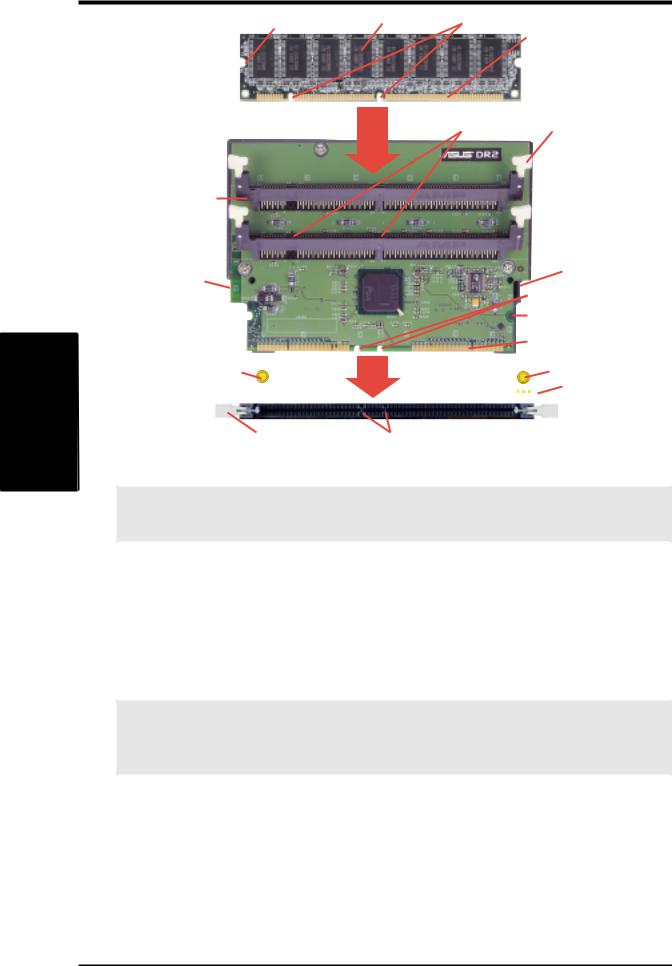
System |
H/W.3 |
Memory |
SETUP |
3. HARDWARE SETUP
MOUNTING NOTCH |
SDRAM |
NOTCH KEYS |
CONNECTORS
RIBS (inside socket) |
EJECTOR |
J1M1
J1M2 |
|
|
|
|
Screw to secure |
|
|||||
|
|
|
|
|
riser to case |
CAPTIVE NUT |
|
|
CAPTIVE NUT |
||
(back of riser) |
|
|
(back of riser) |
||
Screw to secure |
|
|
|
||
riser to case |
|
NOTCH KEYS |
|||
|
|
|
|
MOUNTING NOTCH |
|
|
|
|
|
CONNECTORS |
|
ATTACH MOUNT |
|
|
ATTACH MOUNT |
||
BRIDGE (top view) |
|
|
BRIDGE (top view) |
||
|
|
|
|
|
CPU FAN |
|
|
|
|
|
|
|
|
|
RIMM0 (top view) |
||
|
EJECTOR |
RIBS (inside socket) |
|||
4. Screw the captive nuts into the attach mount bridges.
WARNING! Do not overtighten the captive nut. Doing so could damage your motherboard. Tighten captive nuts to no more than 6±1inch/pound.
5.With the ejectors of the DIMM socket (J1M1/J1M2) in the open position and while holding the riser along its edges, push down gently but firmly on one side of the memory module until it snaps into place and then do the same on the other side. The guides on the socket’s ejectors should go through the two mounting notches on the module and the ejectors should close. If necessary, push the ejectors inward to secure the module in place.
IMPORTANT: When populating both DIMM sockets, the module density on J1M2 must be greater than the one on J1M1. For example, if you are installing a 64MB memory on J1M1, you must install memory greater than or equal to 64MB on J1M2.
Removing Memory from the Riser
1.Unscrew the captive nuts from the attach mount bridge.
2.Push both ejectors (J1M1/J1M2) outward while holding the module along its side edges. Pull the module straight up and out of the DIMM sockets on the riser.
28 |
ASUS P3C-L / P3C-S / P3C-LS User’s Manual |

3. HARDWARE SETUP
General DIMM Notes
•PC100-compliant modules must be used on the riser because of the strict timing issues involved under this speed.
•This motherboard supports SPD (Serial Presence Detect) memory modules. This is the memory of choice for best performance vs. stability.
•BIOS shows your memory type on bootup screen.
•Single-sided memory modules come in 64, 128, 256MB; double-sided come in 128, 256, 512MB.
•The DIMMs must be 3.3V Unbuffered for this motherboard. To determine the DIMM type, check the notches on the DIMMs (see figure below).
168-Pin DIMM Notch Key Definitions (3.3V)
|
|
|
|
|
|
|
|
|
|
|
|
|
|
|
|
|
|
|
|
|
|
|
|
|
|
|
|
|
|
DRAM Key Position |
Voltage Key Position |
|||
RFU |
Unbuffered |
5.0V |
Reserved |
Buffered |
|
3.3V |
|
The notches on the DIMM module will shift between left, center, or right to identify the type and also to prevent the wrong type from being inserted into the DIMM socket on the riser. You must ask your retailer the correct DIMM type before purchasing. The riser supports four clock signals.
.3 SETUPH/W
System Memory
ASUS P3C-L / P3C-S / P3C-LS User’s Manual |
29 |

3. HARDWARE SETUP
(This page was intentionally left blank.)
.3 SETUP H/W
30 |
ASUS P3C-L / P3C-S / P3C-LS User’s Manual |
